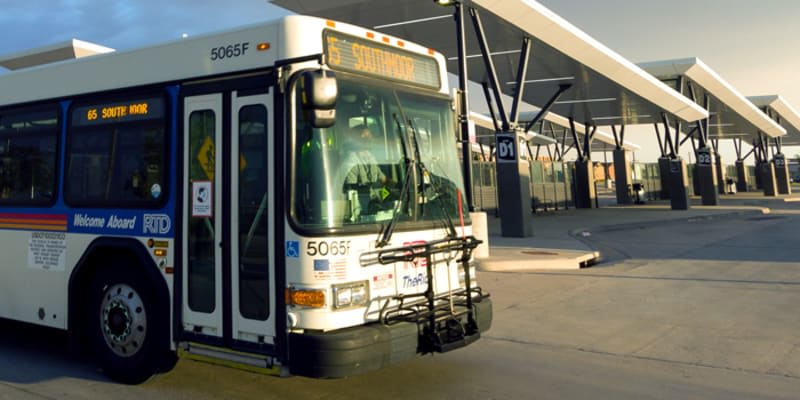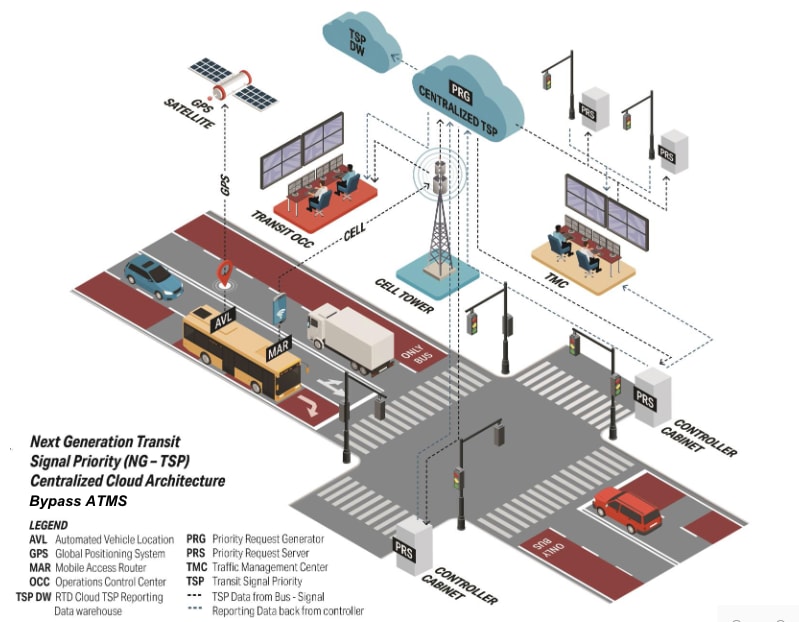
Transit Signal Priority
Continuous Operation Monitoring
RTD and its partner agencies are actively monitoring TSP operations to ensure that the systems are functioning as intended and delivering the expected benefits. Performance monitoring is conducted by analyzing and cross-referencing two key data sources: (1) RTD’s centralized TSP system logs and (2) traffic controller logs maintained by local jurisdictions. This approach allows staff to verify that TSP requests are being properly transmitted, received, and processed.
Next Steps
- Ongoing collaboration with regional partners: As of Summer 2025, RTD is actively working with regional partners to expand Transit Signal Priority (TSP) to new locations. These include five intersections along the SH-119 diagonal section, three locations on Coffman Street in Longmont, and several sites throughout the City of Boulder and Boulder County.
- TSP Conditionality and Data Warehouse: RTD was awarded two DRCOG Technology set-aside funding of around 1 million to enhance RTD's integrated Conditional TSP System & Transit Intelligent Transportation System (ITS) Data Warehouse system. The Conditional TSP system is inherently more robust in utilizing TSP operations and eliminating the impact of TSP on traffic signal systems. This conditional system was integrated into RTD’s centralized cloud-based TSP system in 2023. The Transit ITS Data Warehouse is to provide a centralized repository for efficient access and analysis of transit data (e.g., TSP, ITS, and transit performance data), enabling better decision-making and improved efficiency. A pilot Data Warehouse program has been developed and is coordinating with City and County of Denver to test the system. The project is estimated to be completed in 2026.
- Regional TSP Working Group: RTD has successfully deployed Transit Signal Priority (TSP) along major corridors in Denver, Aurora, and Westminster, enhancing passenger experience by reducing delays and improving bus speed and reliability. As regional interest in TSP grew, a key challenge emerged: supporting multiple systems across partner agencies would require extensive equipment and staff resources. To address this, RTD partnered with the Denver Regional Council of Governments (DRCOG) to form the Regional TSP Working Group, established to formalize and standardize TSP principles and technologies. The Working Group includes representatives from local traffic agencies such as the City of Aurora, City of Boulder, Boulder County, City of Centennial, Colorado Department of Transportation (CDOT) Regions 1 and 4, City and County of Denver, City of Longmont, City of Westminster, DRCOG, and RTD. Members participated in monthly meetings, approved a Working Group Charter, reviewed project deliverables, and provided input on the preferred TSP architecture. Phase 1 of the study concluded in May 2025 with the development of a unified system architecture, which was reviewed and approved by participating agencies. Phase 2 will launch in Fall 2025, focusing on implementation planning, IT security, and advancing collaboration on funding strategies and interagency agreements.
Project Overview
About TSP
Transit Signal Priority (TSP) helps buses move more efficiently through city streets by giving them better coordination with traffic signals. This technology improves on-time performance, makes transfers between buses easier, and enhances the overall rider experience. By reducing the time buses spend idling at intersections, TSP also lowers gas emissions and cuts fuel costs. In some cases, it can even shorten travel times enough that fewer buses are needed to provide the same level of service—delivering both customer benefits and operational savings. Recognizing these advantages, RTD has adopted a centralized could-based TSP system along major transit corridors to improve bus speed and reliability.
TSP Concept of Operations
Typically, TSP operation allows traffic signal controllers to skip conflicting signal phases, to shorten conflicting phases, to lengthen compatible phases, or to modify phase sequence to serve the transit vehicle. Two primary TSP strategies are 1) Green Extension and 2) Early Green (Red Truncation). More specifically:
- A green extension strategy extends the green time for the TSP movement when a TSP-equipped transit vehicle is approaching. The green extension is one of the most effective forms of TSP since a green extension does not require additional clearance intervals.
- An early green strategy shortens the green time of the preceding phases to expedite the return to green (i.e., red truncation) for the movement where a TSP-equipped vehicle has been detected. This strategy only applies when the signal is red, and a TSP-equipped vehicle is approaching. Both green extension and early green strategies are available together within TSP enhanced control environment but are not applied to the same signal cycle.
RTD TSP System Architecture
RTD has implemented a centralized, cloud-based Transit Signal Priority (TSP) system that capitalizes on existing cellular communications and on-board technologies. This modern approach integrates seamlessly with RTD’s Computer-Aided Dispatch/Automatic Vehicle Location (CAD/AVL) and Automatic Passenger Counting (APC) systems to enable real-time, data-informed TSP system. As a bus approaches a TSP-equipped intersection, the system evaluates schedule adherence and passenger load. If thresholds are met, a signal priority request is transmitted to the jurisdiction’s traffic controller. This strategy enhances service reliability, supports operational efficiency, and minimizes the need for new infrastructure investments.
TSP Application Reference Materials and Contact Info
Several reports on Transit Signal Priority (TSP) have been developed for public reference. To request a copy or ask questions about Transit Priority (e.g., TSP, Queue Jump, Bus Bypass), please contact [email protected]. Key reports include:
- RTD Transit Signal Priority (TSP) Application Guidelines (2019): An internal guide outlining what TSP is, its benefits, and key considerations for implementation. It provides step-by-step guidance for developing TSP projects within RTD. Please note that portions of the report are now outdated due to policy updates and system changes.
- Before-and-After TSP Study (2021): An analysis of bus performance, including dwell times, speeds, travel times, and on-time performance before and after TSP deployment. Findings are used by RTD and stakeholders to adjust operations—for example, updating bus schedules or modifying signal timing to improve both transit and general traffic flow.
- Regional TSP System Architecture Report (Phase 1) (2025): Developed to address the growing interest in TSP from different jurisdictions using varying systems in the region. The report summarizes the work of the Regional TSP Working Group, formed by RTD in partnership with the Denver Regional Council of Governments (DRCOG). It outlines a unified strategy and technology framework for deploying next-generation TSP across the Denver metro area, including RTD’s centralized cloud-based system and a Connected Vehicle (CV) pilot in Denver.
Several regional reports have also examined the use of transit priority strategies to guide the planning of future capital improvement projects. Key reports include:
- The Regional BRT Feasibility Study (2019): The study evaluated future corridors within the RTD service area through a data-driven tiered evaluation process. At the conclusion of the study, three to five corridors were identified for future bus rapid transit investment. https://www.rtd-denver.com/about-rtd/projects/regional-bus-rapid-transit-feasibility-study
- The Mobility Choice Blueprint (2019): Mobility Choice Blueprint is a collaborative strategy to prepare the Mile High region for rapidly changing technologies that are transforming the way we travel. We are collectively helping to define the region’s mobility future through a more connected, mobile, adaptable and user-driven network.
Current TSP Operation Status
Active TSP Locations
As of Spring 2024, the TSP system has been installed at nine (9) intersections along Havana St, 14 intersections along E. Colfax Ave., and four (4) intersections along the US-36 corridor in Westminster. Review a summary of where and when TSP has been activated below.
| Corridor | Jurisdiction | Approaches | Location |
|---|---|---|---|
| East Colfax Avenue | Denver | WB | Colfax Ave & Clarkson St |
| East Colfax Avenue | Denver | WB | Colfax Ave & Downing St |
| East Colfax Avenue | Denver | WB, EB | Colfax Ave & Franklin St/Park Ave West |
| East Colfax Avenue | Denver | WB, EB | Colfax Ave & Garfield St |
| East Colfax Avenue | Denver | WB, EB | Colfax Ave & Steele St |
| East Colfax Avenue | Denver | EB | Colfax Ave & Yosemite St |
| East Colfax Avenue | Denver | WB, EB | Colfax Ave & Quebec St |
| East Colfax Avenue | Denver | WB, EB | Colfax Ave & Krameria St |
| East Colfax Avenue | Denver | NB, SB | Colfax Ave & York St |
| East Colfax Avenue | Denver | WB, EB | Colfax Ave & Washington St |
| East Colfax Avenue | Denver | WB, EB | Colfax Ave & Logan St |
| East Colfax Avenue | Denver | WB | Colfax Ave & Grant St |
| East Colfax Avenue | Denver | WB | Colfax Ave & Josephine St |
| East Colfax Avenue | Denver | WB | Colfax Ave & Lincoln St |
| Federal Boulevard | Denver | NB, SB | Federal Blvd & Speer Blvd |
| Federal Boulevard | Denver | NB, SB | Federal Blvd & 35th Ave |
| Federal Boulevard | Denver | NB, SB | Federal Blvd & 33rd Ave |
| Federal Boulevard | Denver | NB, SB | Federal Blvd & 32nd Ave |
| Federal Boulevard | Denver | NB, SB | Federal Blvd & 29th Ave |
| Havana Street | Aurora | WB, EB | Colfax Ave & Havana St |
| Havana Street | Aurora | NB, SB | Havana St & Florida Ave |
| Havana Street | Aurora | NB, SB | Havana St & Idaho Pl |
| Havana Street | Aurora | NB, SB | Havana St & 6th Ave |
| Havana Street | Aurora | NB, SB | Havana St & Mississippi Ave |
| Havana Street | Aurora | NB, SB | Havana St & Montview Blvd |
| Havana Street | Aurora | NB, SB | Parker Rd & Havana St |
| Havana Street | Aurora | NB, SB | Iliff Ave & Havana St |
| Havana Street | Aurora | NB, SB | Havana St & Alameda Ave |
| US 36 | Westminster | EB | Sheridan Blvd & US-36 (@ EB/SB Ramps) |
| US 36 | Westminster | EB | 104th Ave & US-36 (@ EB/SB Ramps) |
| US 36 | Westminster | WB | 104th Ave & US-36 (@ WB/NB Ramps) |
| US 36 | Westminster | WB | Sheridan Blvd & US-36 (@ WB/NB Ramps) |
TSP System Diagram
